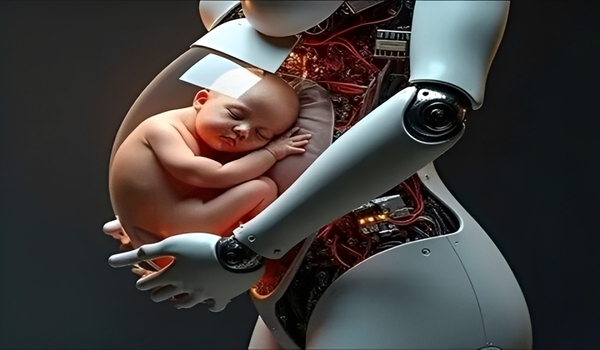A Chinese technology company is preparing to launch what could be the world’s first “gestational robot.”
The concept, developed by Guangzhou-based Kaiwa Technology, consists of a humanoid designed with an artificial uterus embedded in its abdomen, capable of carrying a fetus through a full ten-month pregnancy and giving birth to a baby, according to Chinese media. The robot, with a female appearance, was designed to maintain a constant body temperature, simulate human breathing and heartbeats, and even move and interact, allowing future “parents” to talk to and even “hug” the robot during gestation.
Scheduled for debut in 2026 and priced under 100,000 yuan (about US$13,900), the robot aims to offer an alternative to traditional pregnancy for those who wish to avoid the risks and complications of human gestation. The announcement, made on August 8, 2025, quickly became one of the most searched topics on China’s social media platform Weibo.
The news triggered intense public debate—ranging from ethical concerns to hopeful expectations from infertile couples.
Within China’s broader context of robotic innovation, Chinese researchers also recently unveiled GEAIR, considered the world’s first AI-powered reproductive robot, capable of autonomous navigation and cross-pollination in plants, reducing costs, shortening cycles, and increasing efficiency in agriculture.
The bold proposal of the humanoid gestational robot was presented during the 2025 World Robot Conference in Beijing by Zhang Qifeng, founder of Kaiwa Technology and an affiliated professor at Singapore’s Nanyang Technological University, according to ECNS. According to Qifeng, the project goes beyond a simple incubator: it is a full-sized humanoid equipped with an artificial uterus that can replicate the entire process, from conception to childbirth.

The revelations were made in an interview with Dr. Zhang published on Douyin, the Chinese version of TikTok. In the video, he stated: “I began the development to address the issue of population decline,” adding that although commercial surrogacy is illegal in China, he aims to serve people who do not wish to marry but still want to have children.
The main innovation lies in the artificial uterus, where the fetus develops in synthetic amniotic fluid and receives nutrients through a series of tubes, simulating natural pregnancy. This “external uterus” system is essentially a long-term embryo culture environment. It not only provides oxygen and nutrients but also continuously monitors and records vital signs and fetal development parameters, such as heart rate and oxygen levels, adjusting the environment as needed. Zhang stated that this technology is already well established in laboratory settings, with animal testing showing promising results, and that the next step is to integrate it into a humanoid form, allowing interaction between humans and robots during pregnancy.
The researcher predicts that a prototype of the robot will be ready within a year, at a price below US$13,900. Regarding ethical and legal issues, he said he is already in dialogue with authorities in Guangdong province and that proposals are under discussion as part of ongoing political and legislative deliberations.

The announcement has sparked wide reaction on Chinese social media. Critics condemned the initiative, labeling it ethically questionable and unnatural. Many argued that depriving a fetus of maternal connection would be cruel, while also raising concerns about the source of the eggs used in the process. One Weibo user asked: “Is this even legal? Technology can be used for good, but it should not be used recklessly.”
On the other hand, several users celebrated the innovation, seeing it as a way to spare women from the physical and emotional suffering of pregnancy. One wrote: “Many families spend fortunes on artificial insemination and still cannot have children. The gestational robot could contribute to society.” Another supportive comment added: “This could completely liberate women, allowing humanity to reproduce without pain.”
Dr. Zhang Qifeng stated in his interview that artificial womb technology is already at a mature stage and has shown promising results in animal testing.
What Dr. Zhang describes as an “artificial womb” is based on a line of research that gained worldwide attention in 2017. Scientists at the Children’s Hospital of Philadelphia (CHOP) in the United States developed a system to support the growth of extremely premature lambs outside the womb.

The device, known as the “Biobag,” is essentially a sterile, sealed plastic bag filled with an artificial amniotic fluid (an electrolyte solution). The premature lamb is placed inside the bag, and its own heart pumps blood through an external gas exchange system that functions like a placenta, supplying oxygen and nutrients.
In the study, the lambs — equivalent to a human fetus at 23–24 weeks — not only survived but also continued to develop normally for four weeks. They opened their eyes, grew wool, and developed further, demonstrating that extrauterine gestation was viable.
This was a significant milestone and is often cited as the main proof of concept for artificial womb technology.










